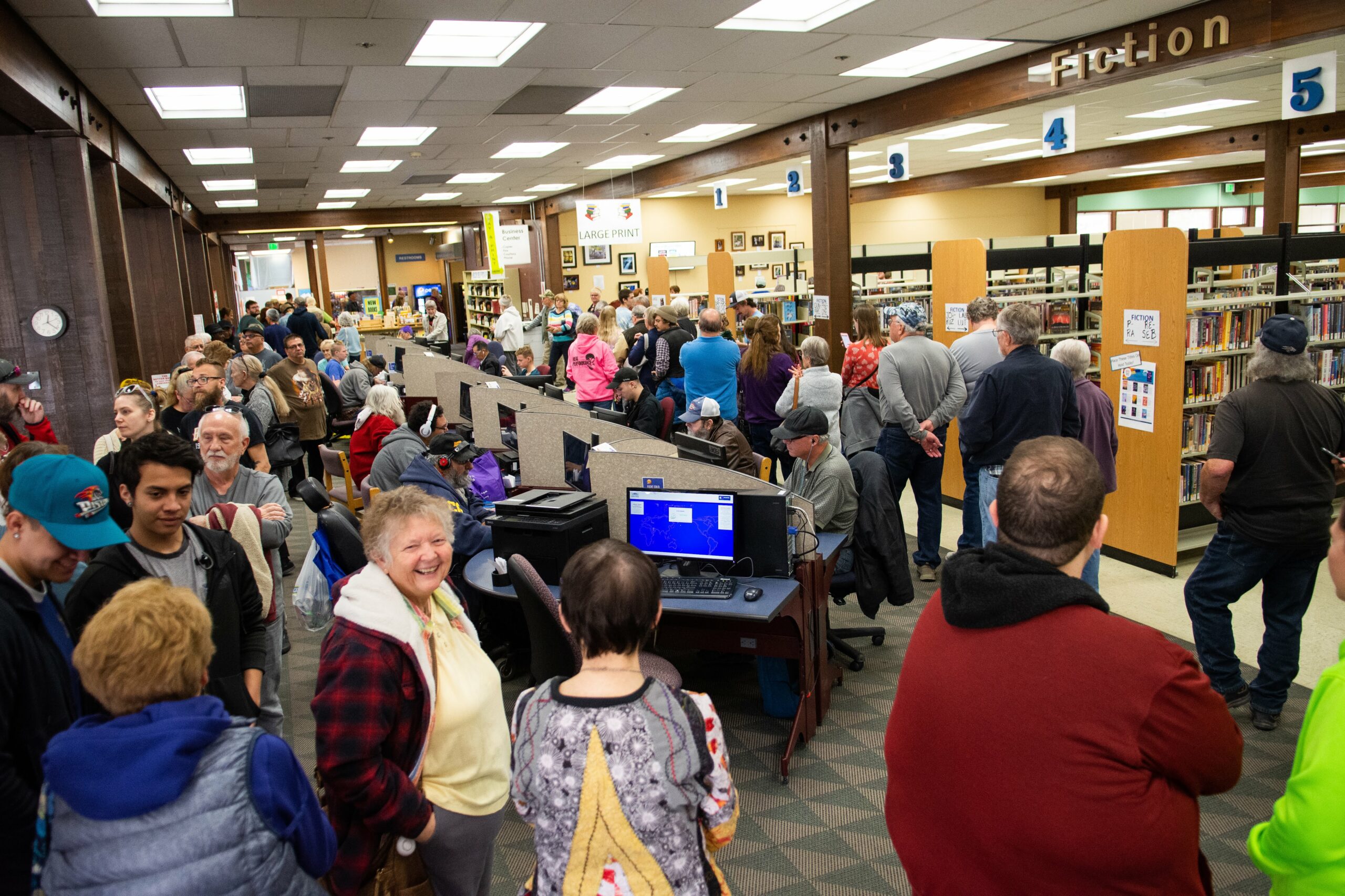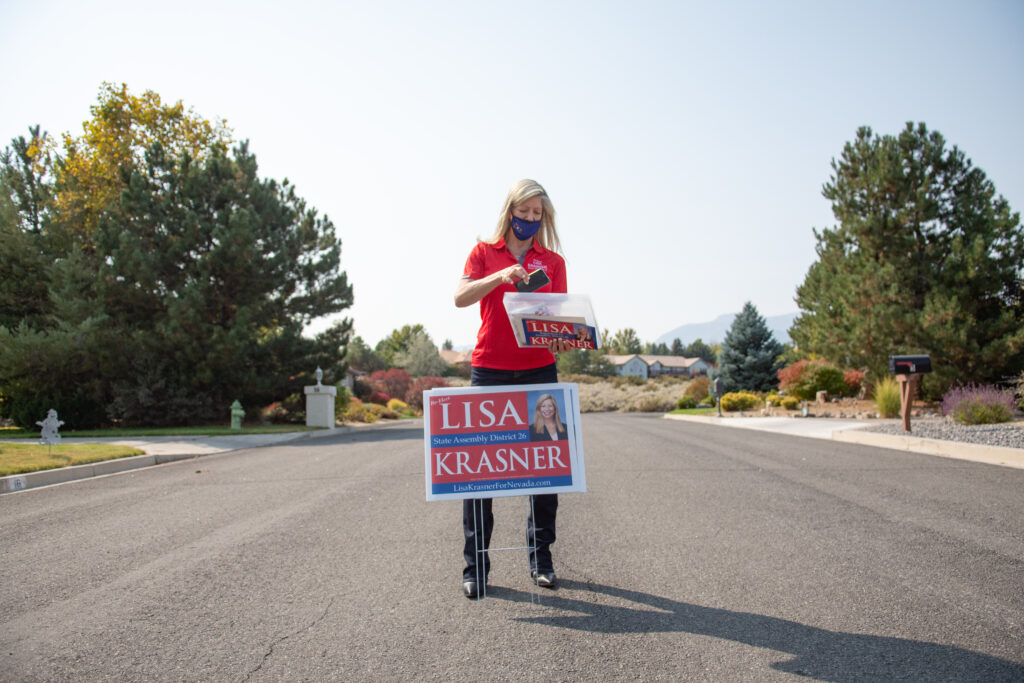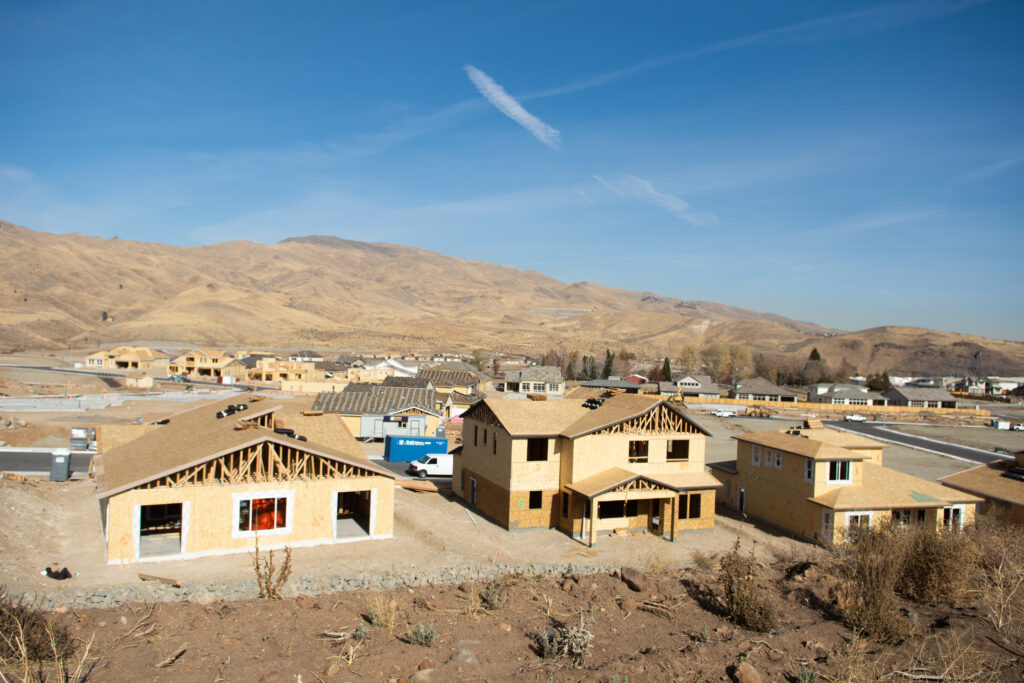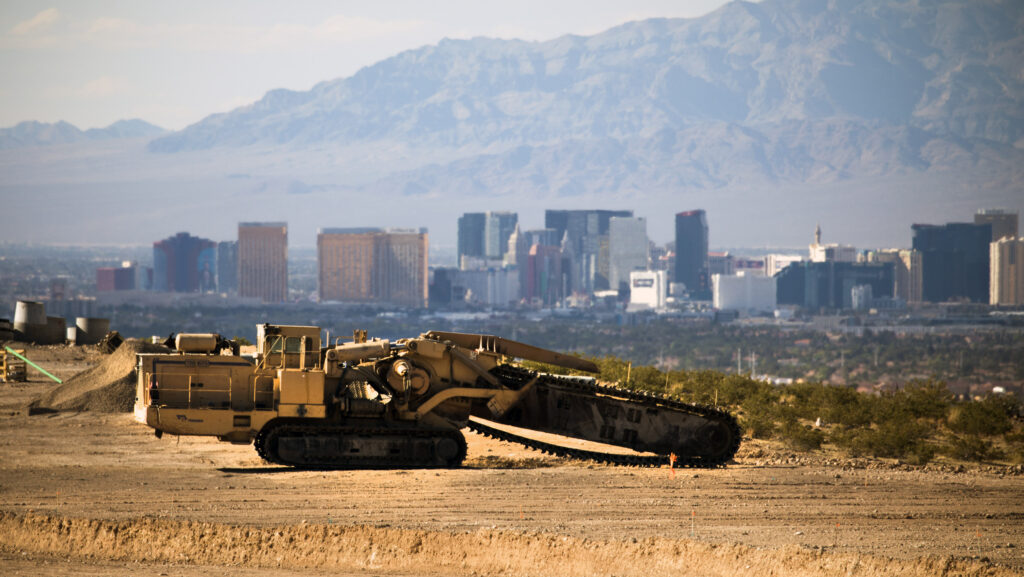Redistricting in Nevada: Uneven population growth foreshadows significant shifts as lawmakers approach redistricting

As lawmakers prepare to draw new congressional and legislative district lines during a special session this fall, The Nevada Independent is bringing you a three-part series to explain why redistricting matters, how the process has historically worked and what to watch for in this year’s redistricting. This is Part III. Read Part I here and Part II here.
As state lawmakers embark on the decennial process of redrawing Nevada's major political boundaries, they face the task of creating districts that ensure equal representation for residents.
That task, however, is far from straightforward.
"There is no neutral way to do it," said Casey Lynch, an assistant geography professor at UNR. "The question is, are you doing it to try to promote a certain sort of partisan political advantage? Are you redistricting, as I think we should in a democracy, to try to make sure that our institutions are as representative as possible?"
Since Nevada’s congressional and legislative districts were last redrawn in 2011, the state’s population has changed drastically. From 2010 to 2020, Nevada’s population increased by more than 400,000 people, fueled by a surge of Latinos and other racial and ethnic minorities in Clark and Washoe counties. But that growth was uneven from district to district, underscoring the need to redraw congressional and legislative maps with balanced populations and racial equity in mind.
Nevada’s population increases and uneven growth in its urban centers mean lawmakers face more work than those in states that have experienced less growth and change, Lynch said. Depending on who is involved in the process, there can be radically different priorities and approaches that can collide, resulting in vastly different outcomes, he said.
While policy makers take into account a number of factors when drawing district lines, the most common state-level criteria include: equal distribution of population, racial equity, contiguity, compactness, preserving existing political subdivisions, such as county and city boundaries, protecting incumbents and maintaining communities of interest or groups that share common values and voting preferences.
Nevada’s Constitution stipulates that “representation shall be apportioned according to the population” and the census “shall serve as the basis of representation in both houses of the Legislature.” Though federal judges have, in the past, mapped out criteria to be used in Nevada’s redistricting process, it’s essentially up to lawmakers to decide what they want to prioritize and every approach has benefits and drawbacks.
For instance, if lawmakers focus on protecting incumbents, Lynch said that could lead to more continuity for residents. But if current lawmakers are no longer representative of the district or state as it has changed, then protecting incumbencies may not make sense, he added.
Lynch said lawmakers need to keep two key concepts in mind when approaching the redistricting process: making sure individual votes hold equal weight across jurisdictions and ensuring racial equity and representation across common interest groups.
The Voting Rights Act prohibited voting practices and procedures, including redistricting plans, that discriminate on the bases of race, color or minority status. Before the protections were enacted and a series of court cases laid a foundation for how to consider race in redistricting, lawmakers across the nation often drew districts that had majority white populations, ensuring people of color would not have the votes to take public office.
To ensure there are adequate opportunities for minority and special interest communities to elect representatives that reflect their values, Lynch said lawmakers can draw districts guaranteeing those populations are not left out of the democratic process. Ideally, the redistricting process should take into account both quantitative measurements, such as population size and racial representation, and qualitative ones, such as shared social values, he said.
How lawmakers will choose to approach this year’s redistricting process in the Silver State remains to be seen. While the governor holds veto power and redistricting plans can be challenged in court, the Legislature has the ultimate authority to draft and enact district maps, which it is expected to do in a special session in November
In an effort to shed more light on that process, The Nevada Independent dove into the data to better understand how Nevada’s population has changed since 2010, including population shifts within certain demographic and political groups.
Uneven population growth
From 2010 to 2020, Nevada’s population grew about 15 percent, with the most growth taking place in Southern Nevada’s Congressional District 3, which includes Summerlin, Henderson, Boulder City and a large portion of unincorporated Clark County.
The state's growth was unevenly distributed and trends toward urbanization, with major increases in the Las Vegas and Reno areas and loss of population in rural districts. Lynch said that means lawmakers have a significant amount of work ahead of them to figure out how to redraw representative district boundaries.
Uneven growth also portends potential political shifts, he said.
“I’d say the growth in itself doesn't necessarily mean anything if it was more or less evenly distributed,” Lynch said. “But looking at the data, you can see there are some significant shifts both spatially and racially in all kinds of ways that means that redistricting is going to be really consequential for the next 10 years.”
Lynch noted that much of the population growth occurred in suburban areas, meaning that lawmakers overseeing the redistricting process will have to make tough decisions about how to address the state’s growing suburbanite population.
“Can you have suburban districts? Or are you lumping … parts of suburbs more with cities, other parts of suburbs more with rural areas?” Lynch said. “That sort of comes down to much more complexly geographic questions of communities of interest.”
State Senate District 9 is one of those areas. Encompassing much of Las Vegas’s southwestern suburbs, it saw the highest population growth of any Senate district over the last 10 years.
Represented by Sen. Melanie Scheible (D-Las Vegas), the district’s almost 60 percent growth in population (58.7 percent) could leave it open for division, with the population roughly 38 percent larger than what it ideally should be, according to analyses from the Legislative Counsel Bureau.
Most of Senate District 9’s growth was concentrated within Assembly District 35, one of the two Assembly districts nested inside the Senate district. The district, which borders the western boundaries of Las Vegas and is represented by Assemblywoman Michelle Gorelow (D-Las Vegas), experienced a 62 percent growth rate, leaving it about 42 percent larger than is ideal.
Assembly District 9, which borders Assembly District 35 in Las Vegas’ southwestern suburbs and is represented by Assemblyman Steve Yeager (D-Las Vegas), also has about 35 percent more population than ideal after experiencing roughly 54 percent growth between 2010 and 2020.
Districts in Northern Nevada and rural parts of the state also experienced growth, albeit at slower rates.
The highest growth rates in those areas took place in Assembly District 36 (41.7 percent growth) covering parts of Clark County, Lincoln County and Nye County and represented by Assemblyman Gregory Hafen (R-Pahrump) and Assembly District 26 branching from Lake Tahoe to Reno and past Pyramid Lake (24.3 percent growth). Assembly District 26 is represented by Assemblywoman Lisa Krasner (R-Reno).

Populations within those larger-than-ideal districts could be absorbed into neighboring districts or form new ones, depending on community priorities and differing representation needs. Decisions surrounding how to distribute populations could also result in the addition of new Assembly and Senate districts.
Lynch noted there also may be cases where lawmakers want to preserve a suburban block that possesses an identity of its own by drawing that district in a way that would allow it to have its own representation, instead of being lumped in with those residing closer to the city.
Not all districts experienced growth over the last decade, though. Assembly District 11 and Assembly District 21, located in northeastern and southeastern Las Vegas, respectively, and represented by Democratic lawmakers, experienced population decreases of about 5 percent, leaving the two districts with populations that are about 17 percent smaller than ideal.
And out of Nevada’s 42 Assembly districts, 19 had less than 10 percent growth rates, with almost no growth taking place in Assembly District 10, which only had a 1 percent growth rate between 2010 and 2020. Assembly District 10 covers the center of Las Vegas, branching out toward the Spring Valley area.
As lawmakers look to redraw the district boundaries, measurable traits such as population and compactness aren’t the only way to evaluate community growth and change. Though it may be easier to hand the redistricting process over to a technocratic appointed body that takes only measurable factors such as continuity, compactness, preservation of subdivisions and population size into account, that can result in communities lacking representation, Lynch said.
“Just saying, ‘Okay, we can draw a block, there's people here,’ you could do that in a way in which you end up with almost all or a super majority of white conservative men in a state that is not majority white conservative men,” Lynch said.
He pointed to the state’s decision to open up a public web-based redistricting application where individuals can submit redistricting plans as one example of a way to include the community and expand beyond solely quantitative breakdowns.
“What communities are represented, how people are grouped together, how we think about community, how we think about identity, all those things are happening, they're just often not really spoken about, as explicitly in this process,” Lynch said. “And I actually think it would be beneficial to be sort of more open about that and reflect on that.”

White population declines, growth among other racial groups
As Nevada’s population increased, the state experienced growth across all racial groups, except for its white population, which declined about 11 percent from 2010 to 2020.
Despite the growth of minority populations, white populations still make up the largest racial group in the state, representing 51.2 percent of the total population. In 2011, white people accounted for 66.2 percent of the population.
The most growth took place among Nevada’s American Indian and Alaska Native population, which increased 89.1 percent from 2010 to 2020 and now accounts for 3.4 percent of the state’s population. Those identifying as Native Hawaiian and Pacific Islanders followed with an almost 60 percent increase, resulting in the population representing about 1.7 percent of the population. Nevada’s Black and African American population grew 47.5 percent and makes up about 12 percent of the population.
As lawmakers create and adjust voting districts, they need to keep in mind that those districts can be drawn to include or exclude communities or create more representation for overlooked minority populations, Lynch said.
“There’s a sense in which this redistricting creates a political community as much as it reflects our views and our decisions about community,” Lynch said. “It also activates people in different ways. It determines who we're in conversation with, who we're evaluating as representatives ... It can empower or disempower communities.”
From 2010 to 2020, Assembly District 11, represented by Democratic Assemblywoman Bea Duran and located primarily in Downtown Las Vegas, experienced the largest decrease in the state’s white population, with more than half of its white population leaving the district. As of 2020, the district’s white population makes up 22 percent of the total population, down from 44 percent in 2011.
In contrast, Assembly District 35 saw the most growth in its white population, with a 25.7 percent increase from 2010 to 2020. White people comprise about 44.3 percent of the district. That’s largely because the district experienced the most population growth of any Assembly group overall.
Changes within the Black and African-American community
In 2010, Black and African American residents of Assembly District 9 made up about 10 percent of the district’s population. In 2020, the group was roughly 13.2 percent of the population and experienced a 100.9 percent growth rate between 2010 and 2020.
However, high rates of growth don’t always indicate that a racial or ethnic group now makes up a significant portion of that district’s population. Take Assembly District 16, which saw its Black and African American population grow by 76.8 percent — significant, but smaller growth than Assembly District 35 saw. However, Black and African American individuals made up nearly 23 percent of the district’s population in 2020, up from 13.8 percent in 2010 — nearly double Assembly District 35’s Black and African American representation.
Lynch said lawmakers ideally should take a close look at each community and try to understand its dynamics before making any determinations about boundaries.
“Is there a community of interest that should be kept together? Does that sort of transcend those boundaries?” Lynch said. “Is that sort of a new predominantly community of color in that area? Or is it a spillover from another district so that now it would make more sense to have a district here rather than a district here?”
Preserving those community interests may, however, conflict with efforts to preserve incumbencies, an approach that was prioritized during Nevada’s 2011 redistricting process.
Asian population grows rapidly on edges of Las Vegas Valley
Statewide, Nevada’s Asian population grew by close to 50 percent from 2010 to 2020 and now makes up about 11.4 percent of the state’s population. The most growth took place in Assembly District 36 which covers rural areas surrounding Las Vegas and spreads into Lincoln County and Nye County, where the Asian population grew by a little more than 238 percent. Though the population grew at a faster rate than other districts, Asians still only make up 7.5 percent of the district’s population — a stark contrast with Assembly District 35 where Asians make up about 29.5 percent of the population.
One of the most significant population shifts in the Asian population took place in Assembly District 8, which covers parts of Spring Valley and is represented by Democratic Assembly Speaker Jason Frierson. Asians now make up about 27.8 percent of the district’s population — the second highest percentage of any other Assembly district after Assembly District 35. In 2011, Assembly District 8 had the third-highest Asian representation (21.4 percent), after Assembly District 35 (25.7 percent) and Assembly District 9 (23.4 percent).
Latinos make up nearly a third of Nevada residents
Nevada’s Latino population grew by about 24.3 percent from 2010 to 2020, now representing almost 29 percent of the state population. In Southern Nevada, Assembly District 35 saw its Latino population grow 85.7 percent between 2010 and 2020 — the most Latino growth experienced by any Assembly district in the state. In 2010, Latinos represented about 16.2 percent of the district’s population. Now, they represent around 18.7 percent of all residents of the district.
Assembly District 14, covering a portion of northeastern Las Vegas, meanwhile, shifted more heavily Latino than any other Assembly district, with the group making up 58.5 percent of the district’s total population in 2020, up from 49.9 percent in 2010.
Northern Nevada’s Assembly District 31, which covers an area stretching from Sparks to northern parts of Reno bordering Silver Lake and is represented by Republican Assemblywoman Jill Dickman, saw its Latino population grow by more than 54 percent from 2010 to 2020. Latinos now make up 27.4 percent of the district’s residents, up from 21 percent in 2020.
Only three Assembly districts experienced decreases in their Latino populations, including Assembly District 10 (2.5 percent), Assembly District 11 (5.7 percent) and Assembly District 16 (7.7 percent). Those districts primarily cover the center of Las Vegas.
Though Latinos represent a broad swath of Nevada’s population, the community is not monolithic. Lynch urged lawmakers to take into account differences within populations when drawing district boundaries and determining communities of interest.
Race presents in nuanced ways, he said, noting that the community of interest criteria intersects with racial equity, though the two criteria are not synonymous. For example, the census may describe two communities as predominantly Latino, though one may be a conservative Cuban community and the other a more liberal Central American community.
The other factor that lawmakers need to consider when approaching communities of color is not splitting up racial groups to dilute their political voice, Lynch said. Even if a minority community only represents a small portion of a district, if lawmakers divide that group, they could be disenfranchising those voters.
To that end, leaders from communities of color are watching the redistricting process closely and figuring out ways to mobilize individuals to participate in the redistricting process.
During a recent virtual community meeting focused on the Latino community, attendees expressed a desire to figure out a way to boost civic engagement and ensure districts are not drawn that make it more difficult for Latinos to be elected to public office and have their voices heard.
“It’s going to take the entire Latino community to remind people how important we are to the state and how important we want to maintain our visibility and our voice,” UNLV Boyd School of Law Professor Sylvia Lazos said in a call to action at the end of the meeting.

Increase in nonpartisan voters affects political landscape
While the Democratic-controlled Legislature is likely to emphasize racial equity in the redistricting process, there’s another important factor they will have to consider: politics, and how to grapple with shifting political trends in the state.
That includes, perhaps most notably, the rise of nonpartisans.
From 2010 to 2020, Nevada recorded an increase of more than 600,000 registered voters. During that time, about 260,000 Nevadans registered as nonpartisan voters, which helped more than double the number of non-major party voters in the state.
David Damore, chair of UNLV’s political science department, pointed to several factors that have contributed to that growth, including Nevada’s automatic voter registration system, which added more than 140,000 people to the state’s voter rolls in 2020, same-day voter registration and a larger number of new residents from other states who may not be familiar with Nevada’s politics and choose not to register with a specific party.
“I think, also, you have a lot of disgust about the two party system,” Damore said. “So even though people may not want to register with [the major parties], we do know they vote bipartisan when they get to the general election.”
Even as the state saw the number of registered Democrats and Republicans increase by about 160,000 each, the rise of nonpartisan voters largely overshadowed the growth seen in the two major parties.
In each congressional district and in the majority of Senate and Assembly districts, the share of all voters registered as either Democrat or Republican declined as the population of nonpartisan voters grew in every area of the state.
One notable exception: rural Nevada, where a declining number of Democrats reinforced a Republican advantage in voter registration.
Across Assembly Districts 32, 33 and 38, which collectively encompass wide-ranging portions of rural Nevada east of Washoe County and north of Nye County, the number of registered Democrats declined by around 12 percent from 2010 to 2020, while the number of registered Republicans grew about 38 percent.
Damore attributed that rightward shift to continued Republican outreach in rural parts of the state and a lack of diversity of opinion.
“If you're in a pretty homogenous place, where you're interacting with the same people over and over again through extended periods of time, you tend to sort of all take on the same attitudes,” he said.
The declines in Democratic registration in those three districts marked a significant departure from the trends seen throughout the rest of the state; the number of registered Democrats increased in every other Assembly district during that time. The number of voters registered as Republicans, as nonpartisans or with a third party also increased in every Assembly district from 2010 to 2020.
Even in heavily Democratic Assembly Districts 10 and 14, within Las Vegas, which saw less population growth than many other parts of the state, the number of registered Republicans still rose by a hair — 39 and 14 people, respectively.
Damore described the partisan divide across the state as one that follows the “blue metros, red states phenomenon,” which occurs as urban areas of a state become more Democratic and non-urban areas of the state become more Republican.
But he noted that Nevada is a “weird case” because so much of the population is concentrated in Clark County, resulting in Southern Nevada having the most of all types of voters — “the most Democrats, the most Republicans, the most nonpartisans and the most unengaged voters.”
Across most districts in the urban areas of Southern Nevada, registered Democrats significantly outnumbered registered Republicans last year, maintaining advantages recorded a decade prior.
However the sizes of those leads shifted across the Las Vegas Valley. In Senate and Assembly districts located at the western and southern edges of the city, where population growth was highest, the difference between registered Democrats and Republicans grew larger. But that difference shrank in many districts located in central and eastern portions of Las Vegas.
At the same time, several districts that were drawn as swing seats during the last redistricting processes — with relatively even numbers of Republicans and Democrats in the district — have grown either bluer or redder over the last decade, changing the dynamics of those seats over the last few election cycles.
For instance, in Senate District 18, located in the northwest corner of the Las Vegas Valley, registered Democrats outnumbered registered Republicans by just 31 people in 2010, out of more than 70,000 total registered voters in the district. But in the decade since, Republicans have seized an advantage. In 2020, registered Republicans made up nearly 4 percentage points more of the registered voter population than Democrats.
That shift can be seen in Senate District 18’s elections. In 2012, Republican Sen. Scott Hammond beat his Democratic opponent by less than 3 points. In 2016 and 2020, Hammond won each of his races by more than 12 points.
By contrast, Senate District 15, which sits along the Nevada-California border and encompasses part of Reno, has gotten slightly bluer since 2010. A decade ago, registered Republicans outnumbered registered Democrats by more than 500 people; last year, Democrats held a 1,000 voter advantage.
Assembly District 19, meanwhile, experienced the greatest shift in major party registration from 2010 to 2020. A decade ago, registration was nearly even among Democrats and Republicans, with the number of registered voters tipping slightly in favor of Democrats.
But the district, which covers much of Lake Mead and stretches from Boulder City and northeastern parts of the Las Vegas Valley to the Nevada-Utah border, has swung heavily Republican since 2010. Last year, registered Republicans made up 38 percent of the district’s registered voters, compared with less than 32 percent of registered Democrats.
Damore said that those areas “tend to be where the Republicans are holding their own,” as they fall in less urban areas of Clark County.
Damore also said he does not expect to see seats move from north to south, a shift that has happened in past redistricting as Clark County’s population grew rapidly. But with Democrats holding a numbers advantage in the Legislature, Damore said lawmakers in the majority party could redraw districts in a way that favors their voter registration advantages.
“The real trick for Democrats will be … can they draw districts that pack so many Republicans into those seats, that there's enough districts that are safe [for the Democratic party] or that swing or lean their way?” Damore said. “That's the real challenge for them — without making them totally ridiculous-looking and get challenged in court.”

